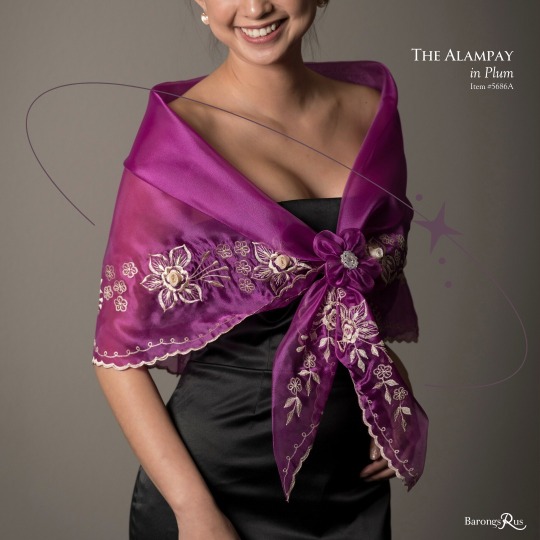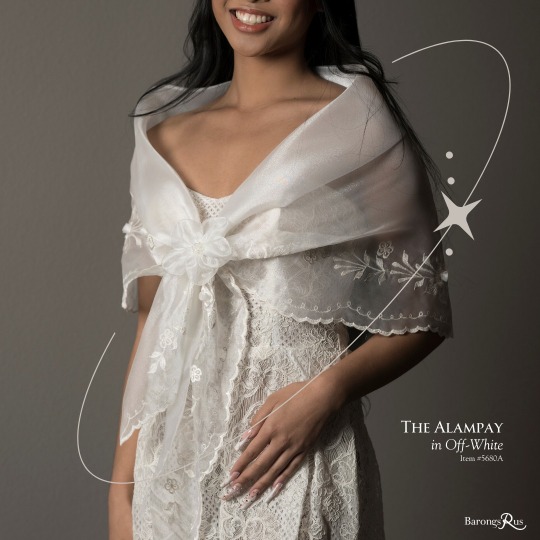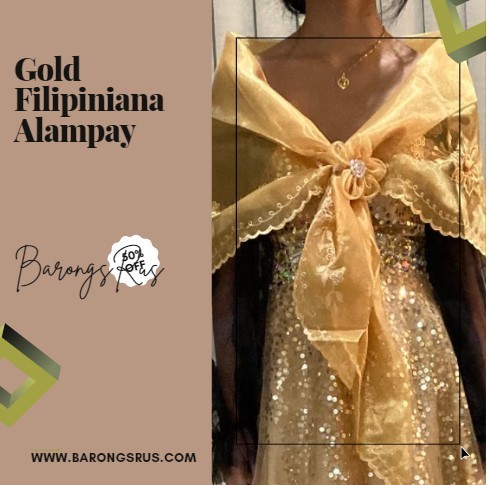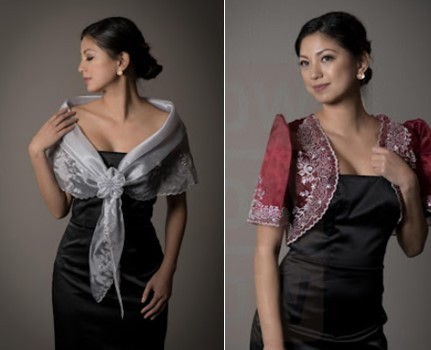#womensbarong
Text


There's nothing like a beautiful Alampay to match your Filipiniana! Matching your Filipinianas with an Alampay of your choice projects beauty and elegance, empowering every woman with a unique sense of style and a connection to her roots.
#barong tagalog#philippines#barong#pinoy#philippines fashion#barongtagalog#barongtagalogforwomen#womensfashion#shopping#barongs#fhilipina#alampy#alampay barong tagalog#kimonadress#womensbarong
8 notes
·
View notes
Text
The traditional Filipino attire has a rich history that reflects the country’s cultural diversity and influences from various civilizations throughout the centuries. The attire has evolved over time, shaped by factors such as climate, social status, trade, and colonial influences. Here’s an overview of the history of traditional Filipino attire:
Pre-colonial Era: Prior to the arrival of Spanish colonizers in the 16th century, the Philippines was home to various indigenous groups with unique clothing styles. The attire varied greatly depending on the region and climate. For example, the Igorot people in the mountainous regions wore woven clothing made from plant fibers, while the Tagalogs in Luzon and Visayans in the central islands wore loose-fitting garments called “Baro” and “Saya” made from cotton or silk.




Spanish Colonial Era: When the Spanish colonizers arrived in the Philippines in the 1500s, they brought their influence on local clothing styles. During this period, the traditional attire evolved to incorporate elements of Spanish fashion. The “Baro” and “Saya” evolved into the “Baro’t Saya,” which is still worn today as a traditional Filipino dress. The “Baro’t Saya” typically consists of a blouse with puffed sleeves and a long skirt called “Saya.”


American Colonial Era: In the early 20th century, the Philippines came under American rule. The influence of Western fashion increased during this period, and many Filipinos adopted Western-style clothing for everyday wear. However, traditional Filipino attire remained an important symbol of cultural identity, and it continued to be worn on special occasions and cultural events.

Post-Independence: After gaining independence from both Spain and the United States, there was a resurgence of interest in Filipino culture and traditional attire. Nationalistic movements promoted the preservation and promotion of Filipino heritage, including traditional clothing.



Modern Times: Today, traditional Filipino attire is still worn during special occasions, celebrations, festivals, and cultural events. The “Baro’t Saya” for women and the “Barong Tagalog” for men, a formal embroidered shirt, are considered the most iconic and formal traditional attires in the Philippines.


The history of traditional Filipino attire showcases the country’s diverse heritage and its ability to embrace its cultural identity despite foreign influences. The “Baro’t Saya” and “Barong Tagalog” continue to be an essential part of Filipino culture, symbolizing national pride and the rich history of the Filipino people.
#barongtagalog#philippines#barongs#philippine culture#filipinopride#custommadebarongtagalog#madeinthephilippines#filipinoculture#filipinowedding#pinoy#womensbarong#Traditional Filipino Attire#Baro’t Saya
6 notes
·
View notes
Text
Filipiniana gowns embody the Filipino people’s rich and diverse cultural heritage and historical roots. Local Filipino dresses are known for their intricate designs matched with vibrant colors.
Over time, the trend of bringing traditional concepts into the modern age is steadily increasing. One of the popular approaches is getting the Filipiniana dress and revamping it with a stylish appearance and style.

This revamped approach has given a new spotlight to shine across these local dresses, but why so? Look into how the Filipiniana dresses and gowns fell from obscurity and made a comeback in the trending modern world.
Traditional Filipiniana Attire
In the old times, Filipiniana traditional dresses were worn as a status of grace. These dresses are designed with intricate patterns and choices of vibrant colors. These gowns are an equivalent to the more modern dresses and gowns people associate with. These gowns help women have a stand-out feel and display their social status during formal occasions.
The Temporary Fall
While traditional gowns were quite popular in its time, in the following years, they have experienced a big decline. Western clothing and fashion trends from outside countries are becoming more prevalent. The recent popularity and influence has made a huge shift for traditional garments.
Many Filipinos opt for contemporary styles in their daily lives, which results in the decline of traditional attire.
The Rise of Filipiniana in the Modern World
Despite its decline long before, recently, there has been a notable resurgence of interest in bringing traditional Filipino fashion back into the spotlight. Many organizations and individual parties within the Philippines have this desire in reconnecting the Filipino people to their roots. They have made tireless efforts to promote and modernize traditional clothing.

This approach has resulted in today’s barong tagalog and Filipiniana gowns adopting a streamline and modernized designs while still keeping many notable features that helps it retain its identity.
Elements of Modern Filipiniana Fashion
As mentioned, many organizations and designers have been implementing different approaches to bringing traditional clothes into the modern age.
Modern Filipiniana fashion incorporates new fabrics and materials, blending them with the traditional design approach. The implementation of modern components makes these attires more comfortable and versatile.
Additionally, Filipiniana dresses, gowns, and sets designed in the modern age often feature new colors and designs. It makes the dresses stand out from their traditional counterpart by having mixed colors and intricate embroidery.
Many fashion and clothing designers experiment with patterns in infusing a fresh approach towards traditional dresses. Furthermore, modern designers would apply innovative creativity in streamlining and enhancing the dresses’ overall style. They adapt modern preferences into traditional styles, offering custom options that fit both worlds.
The Global Appeal of Filipiniana Fashion
Adopting traditional Filipiniana dresses, gowns, and sets has impacted culture. The trend of bringing traditional concepts and putting a modern twist on them has given Filipiniana fashion a big comeback.

The general audience has already begun to show a certain interest in applying traditional clothes to special occasions ranging from weddings to graduation ceremonies.
This trend not only brought traditional fashion back into the local public interests but also garnered significant attention from global audiences. Filipinos from overseas and foreigners have begun implementing traditional wear into their twists at their special events. So, if you are looking for the best Filipinianas for your events, place an order at Barongs R Us today. Contact us for more details!
#barong tagalog#philippines#barong#pinoy#philippines fashion#barongtagalog#barongtagalogforwomen#womensfashion#shopping#barongs#fhilipina#womensbarong#weddingbarong#womens fashion#shoponline#fashion girl#street style#fashion designer
0 notes
Text
youtube
In Philippines wedding, Barong Tagalog always makes an engaging appearance that has gained more popularity and preference with the groom’s attire. Philippine is famous for its wide-ranging market research on consumer products, commercial industries,
#barongtagalog#philippines#barongs#philippine culture#custommadebarongtagalog#filipinopride#madeinthephilippines#filipinoculture#filipinowedding#pinoy#philippineculture#womensbarong#kimonadress#Youtube
1 note
·
View note
Text

Discover the elegance of modern Filipiniana dresses at Barongs R Us!
Our collection features exquisite chiffon and organza fabrics that are both luxurious and comfortable. With a wide range of colors available, you can choose a dress that befits the occasion's theme or simply matches your personal taste.
Shop now at Barongs R Us and showcase your Filipino pride with our modern Filipiniana dresses!
#barong tagalog#philippines#barong#pinoy#philippines fashion#barongtagalogforwomen#barongtagalog#womensfashion#shopping#barongs#fashionblog#fashion designer#louis vuitton#stylish#fashion accessories#philippinewomen#womensbarong#philippineculture#philippine culture#filipinowedding#FilipinoWeddingDress#kimonadress
0 notes
Text
youtube
In the Philippines, Barong Tagalog is considered the national dress of Filipino men. Barong is made with combined elements from native Filipino and Spanish clothing styles. It is traditionally made with Nipis, which is usually woven from Abacá or Piña. Nowadays, Barong has evolved and opened up opportunities for other fabrics and designs to be incorporated into the clothing. In current times, it’s common to witness Barong clothings in different styles and colors. Contrary to tradition, it’s common to see Filipinos not wear the white traditional Barong in various local events such as weddings, christenings, and meetings. Many locals have now opted for modifications and variations in their Barong clothes.
#barongtagalog#philippines#barongs#philippine culture#filipinopride#custommadebarongtagalog#madeinthephilippines#filipinoculture#filipinowedding#pinoy#philippinefashion#barongtagalogforwomen#womensbarong#filipiniana#modernfilipiniana#womensfashion philippinewomen womensbarong barongtagalog weddingbarong barongtagalogforwom philippineculture madeinthephilippines philippin#philipinos girls#philipino#Youtube
1 note
·
View note
Link

An ideal formal blouse for mother of the bride, black tie or other special occasions. The kimona style is fully covered in embroidery with a matching panuelo giving this style a touch of real elegance.
#kimona#kidsfashion#weddingbarong#barongtagalog#barong#philippines#filipinianadress#traditionaldressforwomen#philippinewomen#womensbarong#philippineculture#pinoy#philadelphia
0 notes
Photo

Your next formal event calls for a dress you'll feel confident and stylish in. This timeless design is the perfect choice for your next celebration—trendy with just the right amount of edge. Wear it with heels or flats, depending on the occasion. You can't go wrong with this elegant combination
#philippines#shopping#filipinos#Filipino-American#weddingbarong#barongtagalog#barong#kimonadress#womensbarong
0 notes
Link


Shawl type design of the barong bring an elegant and chic for women. Wear with a spaghetti dress or pair it with black formal dress pants for a style.
#Women’sWrapAroundBarong#fhilipino#womensbarong#barongtagalogforwomen#Filipiniana#filipinoculture#philippines#FilipinianaGown
0 notes
Link

0 notes
Link

Looking for a wedding dress on your special day can be overwhelming. You might want to shop all the dresses you see in every boutique you pass by, or you might be undecided on what you want to wear as so many options are laid out for you. And when it comes to Filipiniana Wedding Dresses, there is no doubt that there are several unique styles that you can try. So if you are looking for a modern filipiniana dress that fits your taste and budget, check out the list below.
#fhilipina#Wedding#Filipino-American#barongtagalog#weddingbarong#womensbarong#barongtagalogforwomen#filipinoculture#barongtagalog barongs philippinecostume filipinoformaldress pinoyshoppingonline pinoyshopping filipinostoresonline Custommadebarongtagalog
0 notes
Photo

“What a lovely piece of clothing!” - Anne
We love hearing your feedback about our filipiniana pieces! If you bought one from our store, be sure to tag us or simply send us a message so we can further improve our products & services.
Start your #BarongsRUs journey today:
☎️ 1(661) 888-2822 or 1(661) 600-7848
🗓 9am - 4pm CT (Monday - Friday excluding holidays)
📲 We ship worldwide at www.barongsrus.com
#barongtagalog#barong#modernfilipiniana#filipiniana#custombarong#womensbarong#fittedbarong#barongs#barongtagalogforwomen#barongsforwomen#formalbarong
0 notes
Link
#womensfashion#philippinewomen#womensbarong#jusilynbarongtagalog#weddingbarong#barongtagalogforwomen#filipinoculture#barongtagalog barongs philippinecostume filipinoformaldress pinoyshoppingonline pinoyshopping filipinostoresonline Custommadebarongtagalog
0 notes
Link
If you're looking for a classy yet elegant outfit, have a look at our collection of Barong Tagalog or Filipiniana Dresses. This beautiful baro at saya will help you turn heads at any formal party! The femnine design, elegant embroidery, and a floor length skirt will keep you feeling elegant all night long!
Color: Beige/Ecru
3 pc. Formal gown (matching alampay included)
With hand beaded floral design
With scalloped edges
Long A-line skirt
2 notes
·
View notes
Link
Another stunning Filipiniana has made its way to the scene, this time by the ever-beautiful Lars Pacheco! Lars has been making a headline in the media outlets in the country since she was crowned as the newest Miss International Queen Philippines 2023. The beauty queen is best known for joining several local pageants and the It’s Showtime’s “Miss Q&A” competition. After winning the MIQP title, she then made a special appearance in her Alma Mater while wearing an intricate Filipiniana dress.
3 notes
·
View notes
Text

A traditional Filipino wedding is a beautiful and culturally rich event that reflects the customs and traditions of the Philippines. It is a celebration not only of the union between two individuals but also of the joining of their families and communities. Here are some elements that often make up a traditional Filipino wedding:
Pre-Wedding Rituals:
Pamamanhikan: This is a formal meeting between the groom’s family and the bride’s family to discuss wedding plans and preparations. It is a way for both families to get to know each other better and to show their support for the union.
Wedding Attire:
Barong Tagalog: The groom typically wears a Barong Tagalog, a traditional Filipino formal attire made from lightweight fabric and intricately embroidered.
Filipiniana or Terno: The bride usually wears a Filipiniana or Terno, which are elegant dresses with butterfly sleeves and intricate details that reflect Filipino fashion and culture.
Ceremony:
Arrhae: This is the presentation of 13 coins (arrhae) by the groom to the bride. These coins symbolize the groom’s promise to provide for the family’s welfare and the bride’s trust in his ability to do so.
Veil and Cord Ceremony: The couple is draped with a veil and cord in the shape of a figure eight, symbolizing their eternal bond and unity as they start their life together.
Cultural Traditions:
Candle Ceremony: The couple lights a pair of candles from a single candle, signifying the merging of their lives and the light of their shared future.
Release of Doves: Releasing doves symbolizes peace, unity, and the couple’s journey into a new life together.
Unity Bowl: The couple combines colored sands in a unity bowl, representing their individual lives merging into one.
Feasting and Celebrations:
A traditional Filipino wedding feast often includes a variety of dishes that showcase the country’s rich culinary heritage. Lechon (roast pig), adobo, lumpia (spring rolls), and various rice-based dishes are commonly served.
Cultural Performances:
Traditional Filipino dances and songs are performed during the reception to celebrate the couple’s union. These performances often highlight the diversity of Filipino culture and history.
Games and Activities:
The “money dance” is a popular wedding tradition where guests pin money on the couple as they dance, providing them with a financial blessing as they start their life together.
Remember that the specific elements and customs can vary depending on the region and the families involved. Incorporating these traditions into your wedding can create a truly memorable and meaningful celebration that pays homage to Filipino culture and heritage.
#barongtagalog#philippines#barongs#philippine culture#custommadebarongtagalog#filipinopride#madeinthephilippines#filipinoculture#filipinowedding#pinoy#fashion barong barongtagalog womensbarong fashion barong barongtagalog womensbarong weddingday pinoy onlineshopping weddingday pinoy online#fashion#menswear#style#high fashion#couture
1 note
·
View note